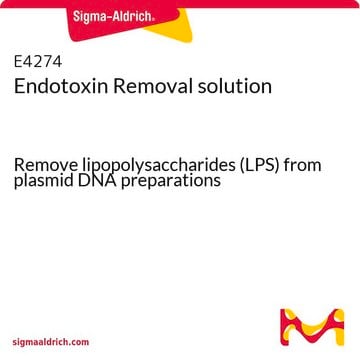추천 제품
생물학적 소스
human
Quality Level
재조합
expressed in HEK 293 cells
무균
sterile
분석
≥95% (SDS-PAGE)
형태
lyophilized powder
분자량
127.5 kDa (The protein migrates as a 140 kDa band on SDS-PAGE due to glycosylation.)
포장
pkg of 50 μg
기술
cell culture | mammalian: suitable
불순물
≤1 EU/μg endotoxin, tested
solubility
water: soluble
NCBI 수납 번호
UniProt 수납 번호
배송 상태
dry ice
저장 온도
−20°C
유전자 정보
human ... THBS1(7057)
일반 설명
애플리케이션
- To treat hepatocyte (IHH) cancer cells to study the role of aspartyl protease 1 (MfSAP1) in extracellular matrix degradation.
- In in vitro Extracellular Matrix (ECM) protein degradation assays.
- In rat C6 astroglioma cells, for coating the cell culture plates to study the effects of integrins on CNTF (ciliary neurotrophic factor) expression.
- In the preparation of secreted factor cocktail for analysis of the human mesenchymal stem cell secretome.
Recommended for use as a cell culture substratum at 1-5 μg/cm2 or 0.1-25 μg/ml. Optimal concentration depends on cell type as well as the application or research objectives.
생화학적/생리학적 작용
특징 및 장점
- Human-derived thrombospondin
- Produced through recombinant expression in HEK 293 cells
- Low endotoxin levels
물리적 형태
분석 메모
Storage Class Code
11 - Combustible Solids
WGK
WGK 2
Flash Point (°F)
Not applicable
Flash Point (°C)
Not applicable
시험 성적서(COA)
제품의 로트/배치 번호를 입력하여 시험 성적서(COA)을 검색하십시오. 로트 및 배치 번호는 제품 라벨에 있는 ‘로트’ 또는 ‘배치’라는 용어 뒤에서 찾을 수 있습니다.
문서
The extracellular matrix (ECM) and its attachment factor components are discussed in this article in relation to their function in structural biology and their availability for in vitro applications.
The extracellular matrix (ECM) is secreted by cells and surrounds them in tissues.
자사의 과학자팀은 생명 과학, 재료 과학, 화학 합성, 크로마토그래피, 분석 및 기타 많은 영역을 포함한 모든 과학 분야에 경험이 있습니다..
고객지원팀으로 연락바랍니다.







